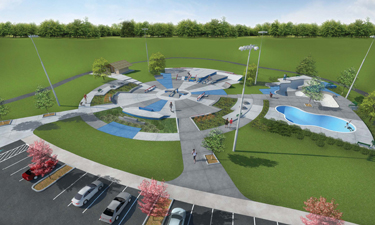 Kennesaw, Georgia, is a welcoming, family-friendly community of 30,000 in the northwest suburbs of Atlanta. The town has many amenities — a Smithsonian-affiliated museum, a 16-acre botanical garden and 130 acres of parks, public buildings and greenspaces. So there’s something for everyone — almost.
Kennesaw, Georgia, is a welcoming, family-friendly community of 30,000 in the northwest suburbs of Atlanta. The town has many amenities — a Smithsonian-affiliated museum, a 16-acre botanical garden and 130 acres of parks, public buildings and greenspaces. So there’s something for everyone — almost.
In the mid-1990s, a park and recreation study was commissioned to determine the community’s recreational needs, adopt standards based on population and design a master plan for development.
“Our master plan included ballfields, tennis courts and trails, but it also identified a weakness: There weren’t any facilities or activities for kids who weren’t into team sports,” says Mark Mathews, a city councilman at the time and Kennesaw’s current mayor.
So began the push for a skateboarding venue. The idea was further supported by a Cobb County analysis that identified a need for a regional skateboarding facility. The analysis showed there were more than 30,000 boarders in the county and there wasn’t a single public facility to support their sport.
A committee was formed to promote fundraising, and many community members rallied behind the effort by signing pledges and making donations. In 2008, a pledge from a local skating enthusiast allowed the city to build a temporary “skate spot,” but the dream of a full-fledged skatepark capable of hosting regional or even national professional events was still the priority. In 2011, the concept of a $1.4 million, 40,000-square-foot park was put before the voters in a special local option sales tax (SPLOST) referendum.
In the meantime, a committee member who was also a sports marketing professional consulted with pro skateboarder Rob Dyrdek about Kennesaw’s project. In the spring of 2010, Dyrdek paid the city a visit and toured the potential site.
“Rob wanted to be an active participant in the project and even agreed to fund the construction drawings,” says project leader and Assistant City Manager Jeff Drobney.
The project moved into the Request for Qualifications (RFQ) stage once the SPLOST passed and a partial funding source was locked in. The onus was now on the city to raise the remainder of the funds required to complete the project. The Swift-Cantrell Park Foundation was formed to take on the challenge.
“It became a chicken-and-egg thing to get people to commit,” according to Mayor Mathews. “We needed a build date to attract sponsorships, but we also needed a commitment from a competitive event to use our facility in order to jump-start construction.”
In January 2013, the city finally began construction on the first phase of the project funded by SPLOST — the skatepark plaza along with additional restroom, parking, landscaping and lighting improvements in Swift-Cantrell Park. Funding for the second phase, including the flow course and bowls, will come from corporate or private donations or grants, not the city’s general fund.
“Seeing the plaza come to life will make all the difference in our ability to attract the sponsors and events needed to complete the project,” Matthews says.
Kennesaw’s facility will be modeled on a street league design and have elements for skateboarders of all skill levels. It will be capable of hosting large and small skateboarding events.
“We see the value of the skatepark in so many dimensions,” Drobney says. “It will provide a safe place for boarders to enjoy their sport, attract tourism, provide an economic boon to local businesses and be another component in our Fit City Kennesaw wellness initiative, which encourages physical activity.”
Pam Davis is the Marketing/Media Specialist for the City of Kennesaw, Georgia.
How We Did It
May 1, 2013, Department, by Pam Davis

